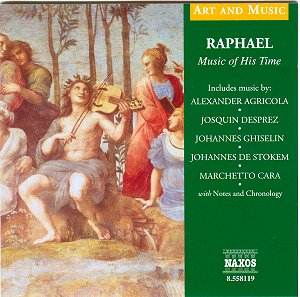The arts of Raphael,
Michelangelo and Leonardo da Vinci form
the basis for the western visual arts.
Their arts and techniques were followed
and built upon by countless artists
working over the centuries in painting,
sculpture and architecture. Their direct
influence could easily be traced through
to artists working in the 19th
century. But it is a curious anomaly
that most musicians working in the 19th
century would have lacked a parallel
appreciation of Raphael’s musical contemporaries.
Developments in music have meant that
the music of Alexander Agricola, Josquin
Desprez and their contemporaries dropped
completely from sight and had to be
rediscovered during the 20th
century as part of a process whereby
the music was explored in parallel with
the rediscovery of older modes of performance.
This attractive recital,
part of a Naxos series which associates
music with the great artists, puts together
a group of pieces that Raphael might
have heard. Well into the 16th
century, the musicians employed at the
Northern Italian courts were predominantly
French or Flemish. The native Italian
tradition is represented by songs known
as ‘frottole’, with their melodic top
part, instrumental accompaniment and
strong harmonic bass. Later in the 16th
century, it is this form which would
develop into the better known Italian
madrigal.
The music on this disc
mixes frottole with the more complex
French chansons. With music by Josquin
and Agricola as well as Marchetto Cara
(a favourite of Isabella d’Este), Johannes
Ghiselind and Johannes de Stokem (these
two latter were both anthologised in
the early 16th century by
the Venetian printer Petrucci. It is
Petrucci who is a key figure in our
knowledge of this music; his books of
motets and 11 books of frottole are
an important source of our knowledge.
The singers and musicians
of Ensemble Unicorn play this music
attractively and infectiously. Methods
of presentation of this type of music
have varied over the years as elaborated
orchestration of the music was replaced
by a more puritan method of presentation.
Ensemble Unicorn favour quite elaborate
orchestrations. This works well in the
movements presented as purely dance
movements, but there were times that
I felt they overdid things in the vocal
movements. I would have liked more songs
sung with a simple accompaniment. But
there is no doubt that the performances
are attractive and will appeal to many
people. Where the disc falls down is
in the opening group of sacred pieces.
Here the same principles of orchestration
have been applied, so that Agricola’s
‘Gaudeamus omnes’ is performed as a
chant sung by the baritone with two
countermelodies carried by recorders.
The result is rather strange and not
satisfactory. Similarly, Josquin’s ‘In
pace’ is performed as a solo accompanied
by strings and recorders. I would certainly
have preferred a more austere presentation
of the sacred pieces. This would have
created a contrast with the secular
ones. Though, at the time, sacred and
secular pieces partook of the same material
I think it is unhelpful to perform them
all using the same methods.
Robert Hugill
see also review
by Bill
Kenny

